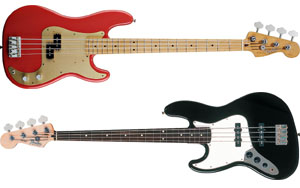Fender Bass Guitars
About the only instrument that might rival the Stratocaster in popularity would be the Fender Precision Bass. It is unquestionably the most popular electric bass of all time. Coupled with the Fender Jazz Bass, Fender had no problem conquering the emerging world of electric bass guitars in the 1950s and it hasn't looked back since.

While it wasn't the first electric bass on the market (Audiovox holds that claim), the Precision Bass was the first electric bass to be mass produced, a method Fender first pioneered with their Telecaster guitar. The original Precision Bass had a single coil pickup on its solid body frame.
As with most popular musical instruments, it took a well-known player to boost the Precision Bass to the status of familiarity it holds today. The important figure in this scenario was Bill Black, the bassist for Elvis Presley. Although Black originally played an upright double bass on many of Elvis' early hits, he later transitioned to the Precision bass and never went back.
The effect that Fender's bass guitars had on the music scene at the time is undeniable. After all, the advantages over an upright acoustic bass are obvious. From a bassist's point of view, which scenario would you prefer? Lug around a large and cumbersome instrument to every gig, only to stand on the stage and be overshadowed and drowned out by horn sections and electric guitars? Or, show up with an easy-to-transport electric bass guitar, plug in and show off your chops and actually be noticed? That's what we thought.
By allowing the bass guitar to be amplified and therefore better heard, it suddenly played a more dominant role in the band and added a lot of depth to the rhythms of popular music. Additionally, the sound was sharper and more defined, and naturally blossomed in the blues, R&B and rock genres.
In 1960 Fender released its popular Jazz Bass model. It was so named, partly because the sound of the bass was slightly different (perhaps one could argue more "jazz-like") but more so because it was thought the shape and contours of the instrument might appeal more to jazz players making the switch from an upright bass. It features three control knobs, one more than its Precision sister bass. Recent models of both the Precision and Jazz feature a fourth control button known as an "S-1" switch. This S-1 switch system allows the bassist to switch from single coil pickups to humbuckers with the push of a button.
|

